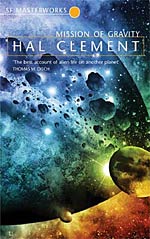
![]() charlesdee
charlesdee
9/11/2011
![]()
The science in "hard science fiction" doesn't have to be all that hard to go over my head. If publishers and critical readers say an author has done his homework and knows what he's talking about, I find myself taking a lot of things on faith. On the other hand, I am just as happy reading Philip K. Dick who ignores the niceties of scientific plausibility and has a fully recovered earth with citizens zipping around in flying cars and planning to colonize the galaxy just a few years after an atomic war.
During a 50 year publishing career, Hal Clement established himself as a master of hard sf. He held degrees in astronomy and chemistry, was a WWII pilot, and taught science at Milton Academy. Mission of Gravity(1954) is generally considered to be Clement's best novel. It appears in the Jim Pringle list of 100 best Science Fiction novels, but the description there goes beyond damning with faint praise. Pringle writes, "Of course the psychology is minimal, the characters wooden, and the prose flat." I finally picked it up with low expectations. I was wrong.
The setting is the planet Mesklin, a dense, discus shaped planet that rotates so rapidly so close to its sun that its gravity ranges from about twice that of earth's when near the equatorial rim to 700 times earth's near the poles. Clement later rethought this, and reduced the maximum gravity to 250 times that of earth, but you get the idea. Mesklin is largely inaccessible to earthling space explorers, and you would think to any form of life whatsoever. But earth has sent a probe to Mesklin which is stranded at the south pole. A research station orbits the planet, and our boots on the ground is a single astronaut names Charles Strickland. His craft must stay near the rim, but there he has found the planets intelligent life form. The Mesklinites are tough-shelled caterpillar like creatures, about fifteen inches long, built low to the ground, and highly intelligent. Barlennan, our Mesklinite hero, leads a group of ocean traders. He has befriended Strickland, who must spend most of his time in his surface craft, learned English, and agreed to undertake the dangerous trip to the pole to retrieve the recording devices off the space probe.
I don't know why Jim Pringle held so low an opinion of the psychology and characterizations of this book. Barlennan and his crew are true adveturers, clever problem solvers, and determined when trading to get the better end of the deal. Strickland and his scientist co-workers orbiting the planet come off as enthusiastic, brainy grad students. A nice period touch is their rush to their slide rules when they need to work out complicated mathematical formulas. (Do they even make slide rules anymore?)
The adventure on the ground involves storms, unfriendly natives, some peculiar beasts in the mid-gravity zones, and the Mesklinites determination to overcome their justifiable fear of heights in a world where a fall of less than a foot would be fatal, The mixture of science and adventure here is closer to the spirit of Jules Verne than any sf novel I have read. Twenty years later, Clement returned to the Mesklinites, transporting them a giant rock in the sky, again inaccessible to earthmen, in a novel called Starlight.
http://www.potatoweather.blogspot.com